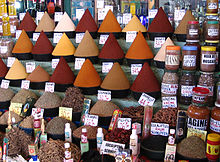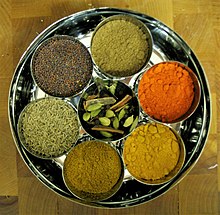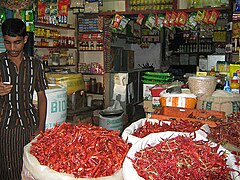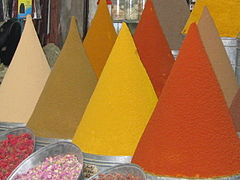Spice
In the culinary arts, a spice is any seed, fruit, root, bark, or other plant substance in a form primarily used for flavoring or coloring food. Spices are distinguished from herbs, which are the leaves, flowers, or stems of plants used for flavoring or as a garnish. Spices are sometimes used in medicine, religious rituals, cosmetics, or perfume production. They are usually classified into spices, spice seeds, and herbal categories.[1] For example, vanilla is commonly used as an ingredient in fragrance manufacturing.[2] Plant-based sweeteners such as sugar are not considered spices.
Spices may be used fresh and whole, after drying, grating, chopping, crushing, or grinding, or by extraction into a tincture. Such processing may happen before a spice is offered for sale, while preparing a dish in a kitchen, or after a dish has been presented for consumption (such as peppercorns ground at the table as a condiment). Some spices such as turmeric are seldom available either fresh or whole and so must be purchased in ground form. Small seeds such as fennel or mustard may be used either whole or in powdered form.
A whole dried spice has the longest shelf life, so it can be purchased and stored in larger amounts, making it cheaper on a per-serving basis. A fresh spice, such as ginger, is usually more flavorful than its dried form, but fresh spices are more expensive and have a much shorter shelf life.
There is not enough clinical evidence to indicate that consuming spices affects human health.[3]
India contributes to 75% of global spice production.[4] This is reflected culturally through its cuisine. Historically, the spice trade developed throughout the Indian subcontinent as well as in East Asia and the Middle East. Europe's demand for spices was among the economic and cultural factors that encouraged exploration in the early modern period.
Etymology
[edit]The word spice originated in Middle English,[5] from the Old French words espece, espis(c)e, and espis(c)e.[6] According to the Middle English Dictionary, the Old French words came from Anglo-French spece;[6] according to Merriam Webster, the Old-French words came from Anglo-French espece, and espis.[5] Both publications agree that the Anglo-French words are derived from Latin species.[5][6] Middle English spice had its first known use as a noun in the 13th century.[5]
History
[edit]Early history
[edit]The spice trade developed throughout the Indian subcontinent[7] and Middle East by 2000 BCE with cinnamon and black pepper, and in East Asia with herbs and pepper. The Egyptians used herbs for cuisine and mummification. Their demand for exotic spices and herbs helped stimulate world trade.
Cloves were used in Mesopotamia by 1700 BCE.[note 1] The earliest written records of spices come from ancient Egyptian, Chinese, and Indian cultures. The Ebers Papyrus from early Egypt dating from 1550 BCE describes some eight hundred different herbal medicinal remedies and numerous medicinal procedures.[11]
By 1000 BCE, medical systems based upon herbs could be found in China, Korea, and India.[citation needed] Early uses were associated with magic, medicine, religion, tradition, and preservation.[12]
Indonesian merchants traveled around China, India, the Middle East, and the east coast of Africa. Arab merchants facilitated the routes through the Middle East and India. This resulted in the Egyptian port city of Alexandria being the main trading center for spices. The most important discovery prior to the European spice trade was the monsoon winds (40 CE). Sailing from Eastern spice cultivators to Western European consumers gradually replaced the land-locked spice routes once facilitated by the Middle East Arab caravans.[12]
Spices were prominent enough in the ancient world that they are mentioned in the Old Testament. In Genesis, Joseph was sold into slavery by his brothers to spice merchants. In Exodus, manna is described as being similar to coriander in appearance. In the Song of Solomon, the male narrator compares his beloved to many saffron, cinnamon, and other spices.[citation needed]
The ancient Indian epic Ramayana mentions cloves.[citation needed]
Historians believe that nutmeg, which originates from the Banda Islands in Southeast Asia, was introduced to Europe in the 6th century BCE.[13] The Romans had cloves in the 1st century CE, as Pliny the Elder wrote about them.[14]
Middle Ages
[edit]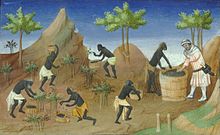
Spices were among the most demanded and expensive products available in Europe in the Middle Ages,[5] the most common being black pepper, cinnamon (and the cheaper alternative cassia), cumin, nutmeg, ginger, and cloves. Given medieval medicine's main theory of humorism, spices and herbs were indispensable to balance "humors" in food,[6] on a daily basis for good health at a time of recurrent pandemics. In addition to being desired by those using medieval medicine, the European elite also craved spices in the Middle Ages, believing spices to be from and a connection to "paradise".[15] An example of the European aristocracy's demand for spice comes from the King of Aragon, who invested substantial resources into importing spices to Spain in the 12th century. He was specifically looking for spices to put in wine and was not alone among European monarchs at the time to have such a desire for spice.[16]
Spices were all imported from plantations in Asia and Africa, which made them expensive. From the 8th until the 15th century, the Republic of Venice held a monopoly on spice trade with the Middle East, using this position to dominate the neighboring Italian maritime republics and city-states. The trade made the region rich. It has been estimated that around 1,000 tons of pepper and 1,000 tons of other common spices were imported into Western Europe each year during the Late Middle Ages. The value of these goods was the equivalent of a yearly supply of grain for 1.5 million people.[17] The most exclusive was saffron, used as much for its vivid yellow-red color as for its flavor. Spices that have now fallen into obscurity in European cuisine include grains of paradise, a relative of cardamom which mostly replaced pepper in late medieval north French cooking, long pepper, mace, spikenard, galangal, and cubeb.[18]
Early modern period
[edit]Voyagers from Spain and Portugal were interested in seeking new routes to trade in spices and other valuable products from Asia. The control of trade routes and the spice-producing regions were the main reasons that Portuguese navigator Vasco da Gama sailed to India in 1499.[8] When da Gama discovered the pepper market in India, he was able to secure peppers for a much cheaper price than the ones demanded by Venice.[16] At around the same time, Christopher Columbus returned from the New World. He described to investors the new spices available there.[19][a]
Another source of competition in the spice trade during the 15th and 16th centuries was the Ragusans from the maritime republic of Dubrovnik in southern Croatia.[20] The military prowess of Afonso de Albuquerque (1453–1515) allowed the Portuguese to take control of the sea routes to India. In 1506, he took the island of Socotra in the mouth of the Red Sea and, in 1507, Ormuz in the Persian Gulf. Since becoming the viceroy of the Indies, he took Goa in India in 1510, and Malacca on the Malay Peninsula in 1511. The Portuguese could now trade directly with Siam, China, and the Maluku Islands.
With the discovery of the New World came new spices, including allspice, chili peppers, vanilla, and chocolate. This development kept the spice trade, with America as a latecomer with its new seasonings, profitable well into the 19th century.[21]
Function
[edit]
Spices are primarily used as food flavoring or to create variety.[22] They are also used to perfume cosmetics and incense. At various periods, many spices were used in herbal medicine. Finally, since they can be expensive, rare and exotic commodities, their conspicuous consumption has often been a symbol of wealth and social class.[18]
Preservative claim
[edit]The most popular explanation for the love of spices in the Middle Ages is that they were used to preserve meat from spoiling, or to cover up the taste of meat that had already gone off. This compelling but false idea constitutes something of an urban legend, a story so instinctively attractive that mere fact seems unable to wipe it out... Anyone who could afford spices could easily find meat fresher than what city dwellers today buy in their local supermarket.[18]
It is often claimed that spices were used either as food preservatives or to mask the taste of spoiled meat, especially in the European Middle Ages.[18][23] This is false.[24][25][26][18] In fact, spices are rather ineffective as preservatives as compared to salting, smoking, pickling, or drying, and are ineffective in covering the taste of spoiled meat.[18] Moreover, spices have always been comparatively expensive: in 15th century Oxford, a whole pig cost about the same as a pound of the cheapest spice, pepper.[18] There is also no evidence of such use from contemporary cookbooks: "Old cookbooks make it clear that spices weren't used as a preservative. They typically suggest adding spices toward the end of the cooking process, where they could have no preservative effect whatsoever."[27] Indeed, Cristoforo di Messisbugo suggested in the 16th century that pepper may speed up spoilage.[27]
Though some spices have antimicrobial properties in vitro,[28] pepper—by far the most common spice—is relatively ineffective, and in any case, salt, which is far cheaper, is also far more effective.[27]
Classification and types
[edit]
Culinary herbs and spices
[edit]Botanical basis
[edit]- Seeds, such as fennel, mustard, nutmeg, and black pepper
- Fruits, such as Cayenne pepper and Chimayo pepper
- Arils, such as mace (part of nutmeg plant fruit)
- Barks, such as True Cinnamon and cassia
- Flower buds, such as cloves
- Stigmas, such as saffron
- Roots and rhizomes, such as turmeric, ginger and galangal
- Resins, such as asafoetida
Common spice mixtures
[edit]- Advieh (Iran)
- Baharat (Arab world, and the Middle East in general)
- Berbere (Ethiopia, Eritrea and Somalia)
- Bumbu (Indonesia)
- Cajun (United States)
- Chaat masala (Indian subcontinent)
- Chili powder and crushed red pepper (Cayenne, Chipotle, Jalapeño, New Mexico, Tabasco, and other cultivars)
- Curry powder
- Five-spice powder (China)
- Garam masala (Indian subcontinent)
- Harissa (North Africa)
- Hawaij (Yemen)
- Jerk spice (Jamaica)
- Khmeli suneli (Georgia, former U.S.S.R.)
- Masala (a generic name for any mix used in the Indian subcontinent)
- Mixed spice (United Kingdom)
- Panch phoron (Indian subcontinent)
- Pumpkin pie spice (United States)
- Quatre épices (France)
- Ras el hanout (North Africa)
- Sharena sol (literally "colorful salt", Bulgaria)
- Shichimi tōgarashi (Japan)
- Speculaas (Belgium and Netherlands)
- Thuna Paha (Sri Lanka)
- Vegeta (Croatia)
- Za'atar (Middle East)
Handling
[edit]
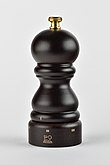
A mortar and pestle is the classic set of tools for grinding a whole spice. Less labor-intensive tools are more common now: a microplane or fine grater can be used to grind small amounts; a coffee grinder[note 2] is useful for larger amounts. A frequently used spice such as black pepper may merit storage in its own hand grinder or mill.
The flavor of a spice is derived in part from compounds (volatile oils) that oxidize or evaporate when exposed to air. Grinding a spice greatly increases its surface area and so increases the rates of oxidation and evaporation. Thus, the flavor is maximized by storing a spice whole and grinding when needed. The shelf life of a whole dry spice is roughly two years; of a ground spice roughly six months.[29] The "flavor life" of a ground spice can be much shorter.[note 3] Ground spices are better stored away from light.[note 4]
Some flavor elements in spices are soluble in water; many are soluble in oil or fat. As a general rule, the flavors from a spice take time to infuse into the food so spices are added early in preparation. This contrasts to herbs which are usually added late in preparation.[29]
Salmonella contamination
[edit]A study by the Food and Drug Administration of shipments of spices to the United States during fiscal years 2007–2009 showed about 7% of the shipments were contaminated by Salmonella bacteria, some of it antibiotic-resistant.[30] As most spices are cooked before being served salmonella contamination often has no effect, but some spices, particularly pepper, are often eaten raw and are present at the table for convenient use. Shipments from Mexico and India, a major producer, were the most frequently contaminated.[31] Food irradiation is said to minimize this risk.[32][33]
Production
[edit]
| Rank | Country | 2010 | 2011 |
|---|---|---|---|
| 1 | India | 1,474,900 | 1,525,000 |
| 2 | Bangladesh | 128,517 | 139,775 |
| 3 | Turkey | 107,000 | 113,783 |
| 4 | China | 90,000 | 95,890 |
| 5 | Pakistan | 53,647 | 53,620 |
| 6 | Iran | 18,028 | 21,307 |
| 7 | Nepal | 20,360 | 20,905 |
| 8 | Colombia | 16,998 | 19,378 |
| 9 | Ethiopia | 27,122 | 17,905 |
| 10 | Sri Lanka | 8,293 | 8,438 |
| — | World | 1,995,523 | 2,063,472 |
| Source: UN Food & Agriculture Organization[34] | |||
Standardization
[edit]The International Organization for Standardization addresses spices and condiments, along with related food additives, as part of the International Classification for Standards 67.220 series.[35]
Gallery
[edit]-
The Gato Negro café and spice shop (Buenos Aires, Argentina)
-
A spice shop selling a variety of spices in Iran
-
Night spice shop in Casablanca, Morocco
-
A spice shop in Taliparamba, India
-
Spices sold in Taliparamba, India
-
Spice seller at a market in Kashgar, China
-
Spice market, Marrakesh, Morocco
See also
[edit]Notes
[edit]- ^ A team of archaeologists led by Giorgio Buccellati excavating the ruins of a burned-down house at the site of Terqa, in modern-day Syria, found a ceramic pot containing a handful of cloves. The house had burned down around 1720 BC and this was the first evidence of cloves being used in the west before Roman times.[8][9][10]
- ^ Other types of coffee grinders, such as a burr mill, can grind spices just as well as coffee beans.
- ^ Nutmeg, in particular, suffers from grinding and the flavor will degrade noticeably in a matter of days.
- ^ Light contributes to oxidation processes.
- ^ The word "ají" is still used in South American Spanish for chili peppers.
References
[edit]- ^ "Spice and herb | Types, Uses, & Facts | Britannica". www.britannica.com. March 8, 2024. Retrieved April 9, 2024.
- ^ Ahmad, Hafsa; Khera, Rasheed Ahmad; Hanif, Muhammad Asif; Ayub, Muhammad Adnan; Jilani, Muhammad Idrees (2020). "Vanilla". Medicinal Plants of South Asia. pp. 657–669. doi:10.1016/B978-0-08-102659-5.00048-3. ISBN 978-0-08-102659-5. S2CID 241855294.
- ^ Vázquez-Fresno, Rosa; Rosana, Albert Remus R.; Sajed, Tanvir; et al. (May 22, 2019). "Herbs and Spices - Biomarkers of Intake Based on Human Intervention Studies – A Systematic Review". Genes and Nutrition. 14 (18): 18. doi:10.1186/s12263-019-0636-8. PMC 6532192. PMID 31143299.
- ^ "Spices Board". www.indianspices.com. Retrieved July 20, 2024.
- ^ a b c d "Definition of SPICE". Merriam-Webster. Archived from the original on August 12, 2022. Retrieved August 12, 2022.
- ^ a b c "spice - Middle English Compendium". quod.lib.umich.edu. Archived from the original on August 12, 2022. Retrieved August 12, 2022.
- ^ Steven E. Sidebotham (May 7, 2019). Berenike and the Ancient Maritime Spice Route. Univ of California Press. ISBN 978-0-520-30338-6. Archived from the original on June 30, 2023. Retrieved April 13, 2019.
- ^ Daniel T. Potts (1997), Mesopotamian Civilization: The Material Foundations. Archived March 26, 2023, at the Wayback Machine A&C Black publishers, p. 269
- ^ Buccellati, G., M. Kelly-Buccellati, Terqa: The First Eight Seasons, Les Annales Archeologiques Arabes Syriennes 33(2), 1983, 47-67
- ^ O'Connell, John (2016). The Book of Spice: From Anise to Zedoary. Pegasus Books. ISBN 978-1-68177-152-6.
- ^ Woodward, Penny (2003). "Herbs and Spices". In Katz (ed.). Encyclopedia of Food and Culture. Vol. 2. Charles Scribner's Sons. pp. 187–195.
- ^ a b Murdock, Linda (2001). A Busy Cook's Guide to Spices: How to Introduce New Flavors to Everyday Meals. Bellwether Books. p. 14. ISBN 978-0-9704285-0-9.
- ^ Burkill, I.H. (1966). A Dictionary of the Economic Products of the Malay Peninsula. Kuala Lumpur: Ministry of Agriculture and Co-Operatives.
- ^ Duke, J.A. (2002). CRC Handbook of Medicinal Spices. CRC Press. p. 7. ISBN 978-1-4200-4048-7. Archived from the original on June 30, 2023. Retrieved May 9, 2017.
- ^ Schivelbusch, Wolfgang (1992). Tastes of paradise : a social history of spices, stimulants, and intoxicants. Pantheon Books. ISBN 0-394-57984-4. OCLC 24702170. Archived from the original on June 30, 2023. Retrieved December 4, 2022.
- ^ a b Freedman, Paul (June 5, 2015). "Health, wellness and the allure of spices in the Middle Ages". Journal of Ethnopharmacology. Potent Substances: On the Boundaries of Food and Medicine. 167: 47–53. doi:10.1016/j.jep.2014.10.065. PMID 25450779.
- ^ Adamson, Melitta Weiss (2004). Food in Medieval Times. Westport, Conn: Greenwood Press. p. 65. ISBN 978-0-313-32147-4.
- ^ a b c d e f g Paul Freedman, Out of the East: Spices and the Medieval Imagination, 2008, ISBN 9780300151350, p. 2-3
- ^ Turner, 2004, p. 11
- ^ Encyclopedia of Jewish Food, p. 453, Gil Marks, John Wiley & Sons, 2010. ISBN 978-0-470-39130-3
- ^ "Mariners Weather Log Vol. 52, No. 3, December 2008". www.vos.noaa.gov. Retrieved October 7, 2024.
- ^ Dennett, Carrie (January 26, 2017). "How a full spice cabinet can keep you healthy". The Washington Post. Archived from the original on February 8, 2023. Retrieved August 12, 2022.
- ^ Thomas, Frédéric; Daoust, Simon P.; Raymond, Michel (June 2012). "Can we understand modern humans without considering pathogens?: Human evolution and parasites". Evolutionary Applications. 5 (4): 368–379. doi:10.1111/j.1752-4571.2011.00231.x. PMC 3353360. PMID 25568057.
- ^ Paul Freedman, "Food Histories of the Middle Ages", in Kyri W. Claflin, Peter Scholliers, Writing Food History: A Global Perspective, ISBN 1847888097, p. 24
- ^ Andrew Dalby, Dangerous Tastes: The Story of Spices, 2000, ISBN 0520236742, p. 156
- ^ Andrew Jotischky, A Hermit's Cookbook: Monks, Food and Fasting in the Middle Ages, 2011, ISBN 1441159916, p. 170
- ^ a b c Michael Krondl, The Taste of Conquest: The Rise and Fall of the Three Great Cities of Spice, 2007, ISBN 9780345480835, p. 6
- ^ Shelef, L.A. (1984). "Antimicrobial Effects of Spices". Journal of Food Safety. 6 (1): 29–44. doi:10.1111/j.1745-4565.1984.tb00477.x.
- ^ a b Host: Alton Brown (January 14, 2004). "Spice Capades". Good Eats. Season 7. Episode 14. Food Network.
- ^ Van Dorena, Jane M.; Daria Kleinmeiera; Thomas S. Hammack; Ann Westerman (June 2013). "Prevalence, serotype diversity, and antimicrobial resistance of Salmonella in imported shipments of spice offered for entry to the United States, FY2007–FY2009". Food Microbiology. 34 (2): 239–251. doi:10.1016/j.fm.2012.10.002. PMID 23541190. Archived from the original on June 16, 2019. Retrieved June 16, 2019.
Shipments of imported spices offered for entry to the United States were sampled during the fiscal years 2007–2009. The mean shipment prevalence for Salmonella was 0.066 (95% CI 0.057–0.076)
- ^ Gardiner Harris (August 27, 2013). "Salmonella in Spices Prompts Changes in Farming". The New York Times. Archived from the original on August 29, 2013. Retrieved August 28, 2013.
- ^ Calucci, L.; Pinzino, C.; Zandomeneghi, M.; Capocchi, A.; Ghiringhelli, S.; Saviozzi, F.; Tozzi, S.; Galleschi, L. (2003). "Effects of gamma-irradiation on the free radical and antioxidant contents in nine aromatic herbs and spices". Journal of Agricultural and Food Chemistry. 51 (4): 927–34. doi:10.1021/jf020739n. PMID 12568551.
- ^ "Myths about Food Irradiation". Center for Consumer Research. June 28, 2017. Archived from the original on July 30, 2022. Retrieved July 30, 2022.
- ^ "Production of Spice by countries". UN Food & Agriculture Organization. 2011. Archived from the original on July 13, 2011. Retrieved December 20, 2013.
- ^ "67.220: Spices and condiments. Food additives". International Organization for Standardization. 2009. Archived from the original on June 6, 2011. Retrieved April 23, 2009.
Further reading
[edit]Books
[edit]- Czarra, Fred (2009). Spices: A Global History. Reaktion Books. p. 128. ISBN 978-1-86189-426-7.
- Dalby, Andrew (2000). Dangerous Tastes: The Story of Spices. University of California Press. ISBN 978-0-520-23674-5.
- Freedman, Paul (2008). Out of the East: Spices and the Medieval Imagination. Yale University Press. ISBN 978-0-300-21131-3.
- Keay, John (2006). The Spice Route: A History. John Murray. ISBN 978-0-7195-6199-3.
- Krondl, Michael (2008). The Taste of Conquest: The Rise and Fall of the Three Great Cities of Spice. Random House. ISBN 978-0-345-50982-6.
- Miller, James Innes (1969). The spice trade of the Roman Empire, 29 B.C. to A.D. 641. Oxford: Clarendon P. ISBN 978-0-19-814264-5.
- Morton, Timothy (2006). The Poetics of Spice: Romantic Consumerism and the Exotic. Cambridge University Press. ISBN 978-0-521-02666-6.
- Seidemann, Johannes (2005). World Spice Plants: Economic Usage, Botany, Taxonomy. Springer. ISBN 978-3-540-22279-8.
- Turner, Jack (2004). Spice: The History of a Temptation. Knopf. ISBN 978-0-375-40721-5.
External links
[edit] Media related to Spice at Wikimedia Commons
Media related to Spice at Wikimedia Commons Cookbook:Spices and herbs at Wikibooks
Cookbook:Spices and herbs at Wikibooks The dictionary definition of spice at Wiktionary
The dictionary definition of spice at Wiktionary

